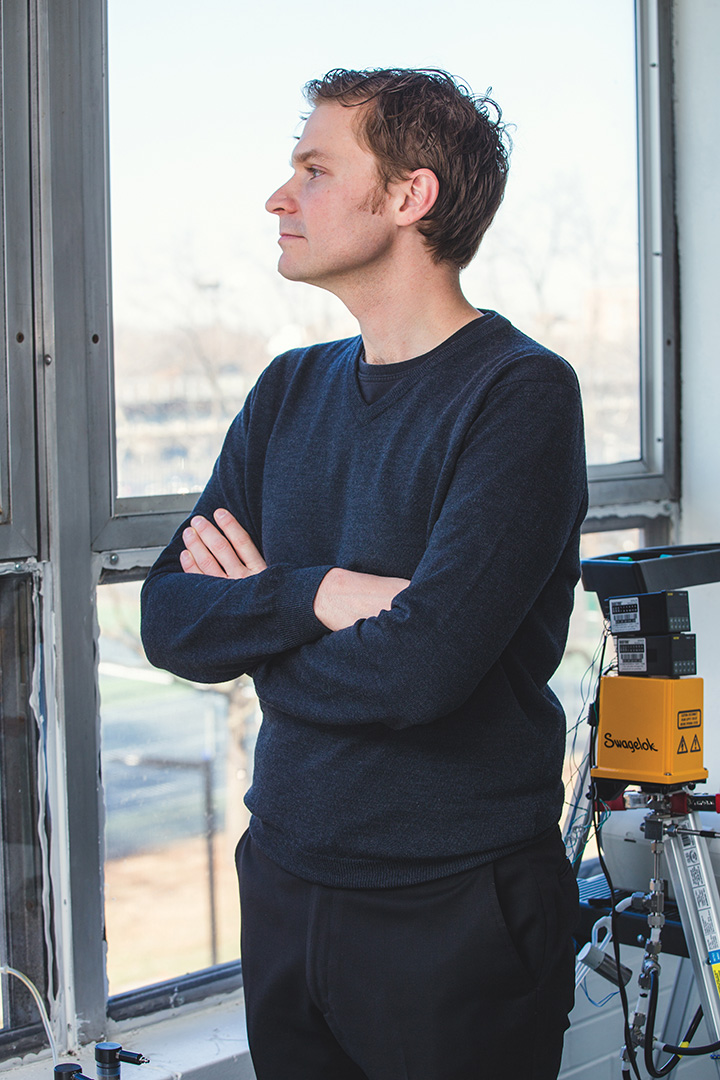It’s been said that some people resemble their pets and with that in mind, Brent Stephens, IIT assistant professor of architectural engineering, likens the structure of a building to its human inhabitants to help explain the diagnostic work that he does. After all, as he notes, people and their buildings spend about 90 percent of their time together.
“The structure of the building is the skeleton of a body, the air-distribution system is the lungs, the electrical system is the central nervous system,” he says, before adding the last of the list with a smile. “And the plumbing system, well, is the plumbing system.”

Photo: Michael Goss
The affable Stephens along with a team composed of five IIT graduate students, several undergraduates, and one post-doctoral researcher focus on a building’s lungs, so to speak, through the Built Environment Research Group. Stephens, who founded the group when he came to IIT almost three years ago, has already garnered plenty of media attention (for his findings on 3-D printer emissions and Metra exhaust hazards) and more than $1 million in funding from government and industry organizations, including his most recent grant from the United States Environmental Protection Agency for $500,000 over a three-year period.
At the request of the EPA, the Institute of Medicine (IOM), the health branch of the National Academy of Sciences, summarized the current scientific understanding of the effects of climate change on indoor air and health. In June 2011, the IOM issued the report “Climate Change, the Indoor Environment, and Health,” in which it issued three key findings: Poor indoor environmental quality is creating health problems today, climate change may worsen existing indoor problems and introduce new ones, and there are opportunities to improve public health while mitigating or adapting to alterations in indoor environmental quality induced by climate change.
The IIT group will be measuring and modeling the amount of outdoor pollutants such as ozone and particulate matter (from sources such as diesel and gas-engine exhaust, plant emissions, wildfire dust, vehicular wear-and-tear from roadways) in homes across the country. Phase 1 will involve performing hourly indoor air quality modeling of indoor exposures to both indoor-generated pollutants and outdoor-infiltrated pollutants across the U.S. residential building stock under both current and future meteorological conditions.
“We can do a decent job of understanding how we think the hourly weather will change. But there’s also the indirect impact, which is, in response to climate change, we are changing the way we build our buildings; we retrofit more buildings. With more aggressive climate policies, you get more incentives for energy-efficiency retrofits to try to bring energy use down because buildings are such an integral source of emissions of CO2 and other greenhouse gases,” explains Stephens, who had conducted a much smaller study of 20 homes in Austin, Texas, where he completed his graduate studies.
“The oldest, leakiest buildings I had measured there—and one of them was my home—had the highest amount of outdoor pollutant transport indoors. The newest, tightest, most energy-efficient, net-zero-energy home had the least amount. It was a huge difference, at about a factor of 20,” he says.
Phase 2 of the project will then be conducted with the help of the Historic Chicago Bungalow Association, an organization created in 2000 by Mayor Richard M. Daley to help preserve the one and one-half story, brick-faced and stone-trimmed homes that still characterize many neighborhoods in the city and suburbs. Stephens will measure about 30 homes for ozone, particulate matter, and NO2 both before and after the bungalows receive energy-efficiency improvements through the Retrofit Chicago Single-Family Residential Partnership program.
More Online
Built Environment Research Group: built-envi.com
Report on “Climate Change, the Indoor Environment, and Health”: books.nap.edu/openbook.php?record_id=13115